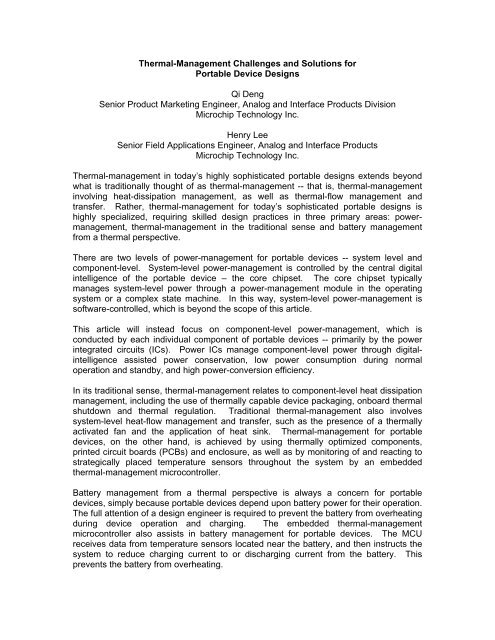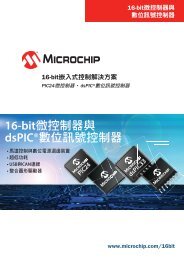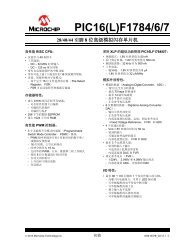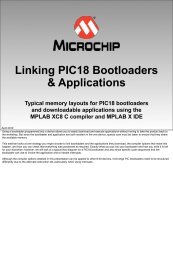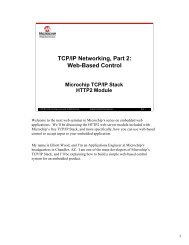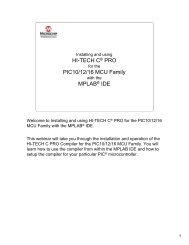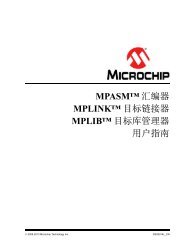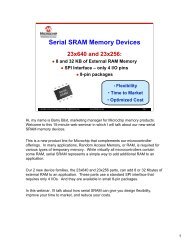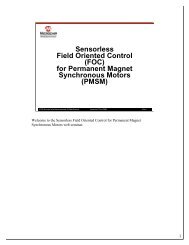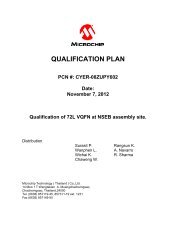An LDO Primer - Microchip
An LDO Primer - Microchip
An LDO Primer - Microchip
Create successful ePaper yourself
Turn your PDF publications into a flip-book with our unique Google optimized e-Paper software.
Thermal-Management Challenges and Solutions forPortable Device DesignsQi DengSenior Product Marketing Engineer, <strong>An</strong>alog and Interface Products Division<strong>Microchip</strong> Technology Inc.Henry LeeSenior Field Applications Engineer, <strong>An</strong>alog and Interface Products<strong>Microchip</strong> Technology Inc.Thermal-management in today’s highly sophisticated portable designs extends beyondwhat is traditionally thought of as thermal-management -- that is, thermal-managementinvolving heat-dissipation management, as well as thermal-flow management andtransfer. Rather, thermal-management for today’s sophisticated portable designs ishighly specialized, requiring skilled design practices in three primary areas: powermanagement,thermal-management in the traditional sense and battery managementfrom a thermal perspective.There are two levels of power-management for portable devices -- system level andcomponent-level. System-level power-management is controlled by the central digitalintelligence of the portable device – the core chipset. The core chipset typicallymanages system-level power through a power-management module in the operatingsystem or a complex state machine. In this way, system-level power-management issoftware-controlled, which is beyond the scope of this article.This article will instead focus on component-level power-management, which isconducted by each individual component of portable devices -- primarily by the powerintegrated circuits (ICs). Power ICs manage component-level power through digitalintelligenceassisted power conservation, low power consumption during normaloperation and standby, and high power-conversion efficiency.In its traditional sense, thermal-management relates to component-level heat dissipationmanagement, including the use of thermally capable device packaging, onboard thermalshutdown and thermal regulation. Traditional thermal-management also involvessystem-level heat-flow management and transfer, such as the presence of a thermallyactivated fan and the application of heat sink. Thermal-management for portabledevices, on the other hand, is achieved by using thermally optimized components,printed circuit boards (PCBs) and enclosure, as well as by monitoring of and reacting tostrategically placed temperature sensors throughout the system by an embeddedthermal-management microcontroller.Battery management from a thermal perspective is always a concern for portabledevices, simply because portable devices depend upon battery power for their operation.The full attention of a design engineer is required to prevent the battery from overheatingduring device operation and charging. The embedded thermal-managementmicrocontroller also assists in battery management for portable devices. The MCUreceives data from temperature sensors located near the battery, and then instructs thesystem to reduce charging current to or discharging current from the battery. Thisprevents the battery from overheating.
The ever-popular Personal Multimedia Player (PMP) will serve as our example toillustrate thermal-management problems and solutions in portable devices. The PMP’sdesign presents almost every potential thermal-management challenge that engineersencounter when designing portable embedded systems (Figure 1).------------- Power------------- SignalFigure 1 – A Typical PMP Block DiagramThermal-Management Challenges and SolutionsI. Power-ManagementThe majority of power-management related thermal problems in portable devices resultfrom excess component-generated heat that does not correctly dissipate from thesystem. Three main power-management related design oversights cause theseproblems.The first oversight involves the use of components that do not provide powerconservationoptions. In our PMP example, if a buck (step-down) regulator without ashutdown function powers the audio block, the entire audio block remains powered,even when the PMP is in standby or operates in a mode that does not require audiooutput. The result is wasted power, not only in the buck regulator, but also in thecomponents of the audio block, such as the CODEC. The wasted power generatesunnecessary heat.
Figure 2 – Integrated Li-Ion Battery-Charger Circuit and Charging ProfileDue to the battery-life and size constraints of PMPs, a fan and/or heat sink cannot beused to transfer heat generated by the PMP’s components. Common design mistakesinclude inadequate thermal optimization of the PCB layout, as well as the improperplacement of components on the PCB and overall enclosure design. All of thesemistakes create heat-transfer problems.For example, on a multi-layer PCB, if the power ground does not have enough surfacearea or metal for heat dissipation, there is not enough surface or thermal conductivity forthe heat to dissipate. As a result, heat may become trapped, which can cause thermalrelatedhazards. To combat this, engineers should practice careful board layout,including enlargement of the power ground with more metal, to avoid thermal traps onthe PCB.Quite often, design engineers neglect to monitor temperatures at potential “hot spots” inportable designs. For example, the backlight white LEDs for LCD displays may becomevery hot. Without a strategically placed temperature sensor in the LCD display module,this overheat is undetectable and, therefore, cannot be eliminated by reducing thecurrent to the white LEDs. This may result in damage to the LCD screen, or even otherparts of the PMP.The placement of temperature sensors at thermally critical points throughout theportable device prevents such overheat. In conjunction with the sensors, a low pin-count,embedded thermal-management microcontroller responds quickly to data from thetemperature sensors, signaling the microcontroller to shut down or reduce power to thehot points in the system.Figure 3 illustrates some thermally critical points in a PMP that must be monitored on areal-time basis in order to avoid thermal runaway.
------------- Power------------- SignalFigure 3 – Thermally Critical Points in a PMPIII. Battery ManagementBattery-management related design problems usually involve battery overheat duringthe charging phase. The charging current cannot be adjusted according to the battery’stemperature if the battery’s temperature is not monitored during charging. Eventually,the battery overheats and is damaged. In extreme cases, the battery may even explodeand inflict physical injury. A temperature sensor or equivalent device, such as athermistor, can be used to monitor battery temperature during charging so that thecharging current can be reduced when overheat occurs.In addition, fuel-gauge ICs that provide real-time monitoring of battery voltage, current,and temperature can be used to monitor the battery. Fuel gauge ICs report this data, aswell as battery capacity data, to the embedded thermal-management microcontroller,which then instructs the system to adjust itself accordingly.ConclusionThere are several steps that designers can take to develop thermally optimized, powerefficientportable device designs. For example, designers can use components withpower conservation options (such as shutdown), low power consumption and highpower-conversion efficiency features.
Components in small, thermally enhanced packages that include thermal regulation andshutdown features promote thermal performance, as do careful board design and layoutpractices on the PCB in order to prevent heat traps. Further, temperature sensorsplaced at thermally critical points throughout the portable device and battery packprovide accurate system-temperature monitoring. When temperature-sensor data isrelayed to a low pin count embedded microcontroller, system-level thermal-managementactivities occur automatically.Figure 4 illustrates a benchmark thermal-management solution, which includes batterycharging and monitoring, power conversion, temperature monitoring, and system-levelthermal-management monitored and managed by an embedded thermal-managementmicrocontroller.------------- Power------------- SignalFigure 4 – <strong>An</strong> Example Thermal-Management Solution for PMP Design


